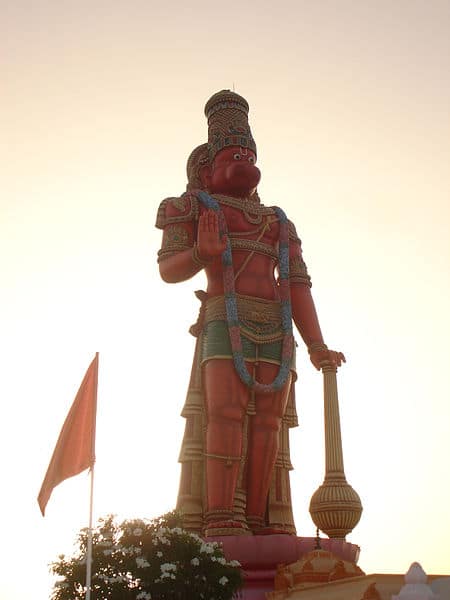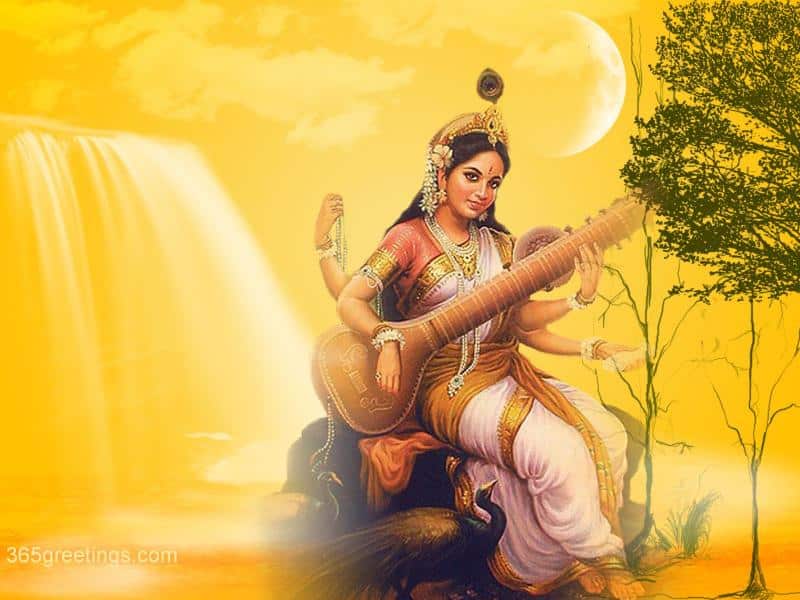Hanuman is a Varana, or a shapeshifting monkey-humanoid from the ancient Hindu epics the Ramayana, the Mahabharata, the Puranas, and Jain texts (Hinduism, Jainism, and Buddhism). He is a steadfast devotee of the god Rama (the seventh incarnation of Vishnu) and is an intricate part of the war against the demon king Ravana. Some texts presume him as an incarnation of lord Shiva, but in many texts he is mentioned as a son of Vayu, god of the wind. The name Hanuman has a few possible origins: one where he was struck in the jaw by Indria, king of the deities where hanu means jaw and man means prominent or disfigured; a second where hanu means killed or destroyed and man means pride, meaning one whose pride was destroyed; and finally a theory that hanuman means male monkey.
Hanuman is an intriguing character in many ways. He is viewed as an ideal devotee or Bhakta to Rama. He was also a lifelong Brahmachari or celibate in his devotion, which is believed to be his source of strength, especially by Indian wrestlers. In one tradition (my favorite) he is said to be born to Vayu and Anjana through the ritual of Dasharatha to have children. The sacred pudding that he gave his wives led to the birth of Rama, Lakshmana, Bharata, and Shatrughna; however, by divine grace some of the pudding fell onto a kite and Vayu brought the kite on the wind to Anjana, in deep worship to Shiva in the forest who consumed the pudding. This led to the birth of Hanuman to Anjana; his mother was a spirit of the clouds and waters also known as an apsara.
The mythology of Hanuman’s childhood is also very interesting. He was quite mischievous during his childhood and would steal things from sages meditating in the forest and re-arrange their sacred artifacts. They placed a curse on him that he could only remember his abilities if he was reminded by another person. He also believed the sun to be a ripe mango and went to eat it, but clashed with Rahu and thrashed him, even though Rahu was supposed to be creating an eclipse. Indra was told of this by Rahu and struck Hanuman with a thunderbolt on the chin, causing him to fall to the earth unconscious. Vayu, upon seeing the attack, withdrew the air from the world. After seeing all of creation asphyxiate, Indra withdrew his thunderbolt and the devas bestowed multiple blessings of power upon Hanuman. In another story, Hanuman learned that Surya,the sun-god, was all-knowing and ascended to the sun to ask for his teaching. Surya told Hanuman that it would be impossible since his chariot was always moving, but Hanuman was undeterred and ended up being a most respected student of Surya.
Hanuman’s adventures occur in the Ramayana, more specifically in the 5th book called the Sundara Kanda. Hanuman meets Rama when Sita was kidnapped by Ravana and Rama’s brother Lakshmana and Rama are searching for her. He disguises himself to find their identities, but upon learning Rama’s identity prostrates himself. Rama then embraces him with warmth, beginning their epic friendship and Hanuman’s devotion to Rama.
Hanuman then begins his own search for Sita, which leads him to cross the sea. But Hanuman laments that his powers are not enough to cross with the other varanas, until Jambavantha reminds Hanuman of his virtues and he leaps across the sea to Lanka, where Ravana’s palace is. He finds Sita there, but she refuses to return with him saying that it would harm Rama’s honor. Hanuman then begins to wreak havoc on Lanka until he allows himself to be subdued and learns the size of Ravana’s armies. He then warns Ravana of Rama’s warning to return Sita to him and offers his forgiveness in return. Ravana becomes enraged and orders Hanuman to be killed until Ravana’s brother intervenes and reminds him that it is against the rules of engagement to kill a messenger. Ravana decides to light Hanuman’s tail on fire, but Hanuman enlarges himself and again wrecks havoc on Lanka, before returning to Rama.
Hanuman also saves his brother, Lakshamana, by delivering an entire mountain to him. Ravana tries several ways to stop him, even by expediting the rise of the sun, Surya. Hanuman grows in size to slow the sun’s rise and delivers the entire mountain to Lanka to save his brother. Rama embraces Hanuman to show that he is as dear to him as a brother and Hanuman releases his grip on Surya with apologies to his guru. Rama holds a celebration to honor his well-wishers and helpers and Hanuman enters without desiring a reward. As Hanuman comes to Rama, Rama is overwhelmed with emotion and embraces him with deep compassion for his work in the war against Ravana. Sita, knowing that Hanuman deserved more honor than any other, gave Hanuman the precious stones around her neck. When he receives it, Hanuman takes apart each stone saying that he won’t accept it unless Rama and Sita are inside. Many unbelieving witnesses watch and question Hanuman, saying he could not possibly be so devoted to Rama and Sita so Hanuman opens his heart to show them Rama and Sita inside.
Hanuman, after the war with Ravana, left to the Himalayas to record the Ramayana, including each detail of Rama’s deeds. Rama then departed for his supreme abode Vaikuntha. Hanuman requested to stay on earth as long as Rama’s name was worshipped. He is immortalized by his actions and is one of the most powerful and venerated gods in Hinduism. Hanuman is also on Arjuna’s flag in the Bhagavad Gita and stays with him during the entire battle, protecting his chariot from celestial weapons until at the end of the battle when Hanuman floats back into the sky, the chariot bursts into flames.
 Hanuman is a god venerated by many traditions spread all over Asia, inferring that he is a very old deity and is intricate to the religious formations over the years. The biggest statue of Hanuman is in Murti and is 85 feet tall. Hanumanasana is the Sanskrit name for the splits in yoga, named that way for how Hanuman leapt over the ocean to rescue Sita.
Hanuman is a god venerated by many traditions spread all over Asia, inferring that he is a very old deity and is intricate to the religious formations over the years. The biggest statue of Hanuman is in Murti and is 85 feet tall. Hanumanasana is the Sanskrit name for the splits in yoga, named that way for how Hanuman leapt over the ocean to rescue Sita.
Who are your favorite Hindu deities?
Hanuman is a fascinating character and worshipped for many of his devotional qualities; how do the stories speak to you about devotion in your life, in relationships, even your Dharma?
What resonates with your about these stories?
Let me know in the comments!


